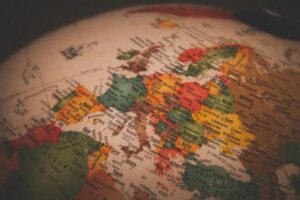Remote sensing sensors are instruments that are used to collect data about the Earth’s surface and atmosphere remotely. These sensors can be placed on aircrafts, satellites, drones, or other platforms and can capture information about the physical properties of the planet, such as temperature, reflectance, and emissions. In this article, we will explore different types of remote sensing sensors and how our object detection platform, FlyPix AI, can leverage the data obtained from these sensors to extract valuable insights.
Optical Sensors
Optical sensors primarily operate within the visible spectrum of electromagnetic radiation and are used to create images of the Earth’s surface. They cinclude traditional cameras that produce color images using red, green, and blue channels, as well as, more advanced versions such as multispectral and hyperspectral imaging cameras.
Visible Spectrum: Visible spectrum sensors capture images using standard colors (red, green, blue) to create colorful representations of the Earth’s surface.
Multispectral & Hyperspectral: Multispectral and hyperspectral imaging cameras go beyond the visible spectrum, capturing images in multiple spectral bands, including visible, near-infrared, mid-infrared, and thermal infrared.
- Infrared: these sensors detect electromagnetic radiation with wavelengths longer than visible light but shorter than radio waves, making them capable of detecting heat radiation emitted by objects.
- Ultraviolet: these sensors can capture ultraviolet radiation, which is shorter in wavelength than visible light and is often used for specialized applications.
Radar Sensors
Radar sensors are a type of remote sensing sensor that use radio waves to detect the Earth’s surface and measure the distance to objects. These sensors emit electromagnetic waves, which bounce off objects and return to the sensor. By measuring the time it takes for the waves to return, radar sensors can calculate the distance to the object and can be used to create a map of the surrounding environment. Some common examples of radar sensors include synthetic aperture radar (SAR) and interferometric SAR (InSAR).
- Synthetic Aperture Radar (SAR): SAR is a type of radar sensor that uses advanced imaging techniques to create high-resolution images of the Earth’s surface. Among others, it can be used to detect and monitor changes in land use, map deforestation or flooded areas and even measure the movement of glaciers.
- Interferometric SAR (InSAR): InSAR is a type of radar sensor that measures surface deformation and subsidence. InSAR uses two or more radar images of the same area taken at different times and compares the differences in the images to create a 3D map of the surface deformation. InSAR can be used to monitor volcanic activity, map earthquake zones, and measure the deformation of glaciers and ice sheets.
Lidar Sensors
Lidar (Light Detection and Ranging) sensors are a type of remote sensing sensor that use laser pulses to measure distance to the object and can be used to create detailed 3D maps of the Earth’s surface and even the seafloor. This makes them incredibly useful for navigation and terrain analysis.
Some common examples of lidar sensors include airborne lidar and terrestrial lidar. Airborne lidar sensors are typically mounted on aircrafts and used for mapping large areas rapidly. Terrestrial lidar, on the other hand, are mounted on tripods or vehicles and are used to create detailed 3D maps of small areas.
Lidar sensors can also be combined with other remote sensing sensors, such as cameras and multispectral scanners, to provide additional information about the Earth’s surface.
Electromagnetic Sensors
Electromagnetic sensors are devices that detect and measure electromagnetic waves, which are oscillating electric and magnetic fields propagating through space. These sensors are employed to gather information about different aspects of the environment, including physical properties, electromagnetic phenomena, and even the presence of certain materials. Some common examples of elctromagnetic sensors include magnetic, microwave and radio frequency sensors.
Conclusion
There is no doubt that remote sensing sensors have become an essential tool for monitoring and understanding the Earth’s surface and atmosphere. From monitoring weather patterns and mapping natural resources to tracking the movements of vehicles, remote sensing sensors can be used in a variety of applications.
Our object detection platform, FlyPix AI, can analyse data obtained from various remote sensing sensors to detect and track objects, making it a powerful tool for applications such as surveillance, transportation, and environmental monitoring. In addition to detecting and tracking objects, FlyPix AI can also be used in combination with remote sensing sensors to monitor changes and detect anomalies, providing valuable information about the Earth’s surface, such as the health of crops and vegetation, and the presence of fires or other environmental hazards.
We believe that remote sensing sensors and platforms like FlyPix AI have the potential to revolutionise the way we monitor and understand the Earth’s surface, and as these technologies continue to advance, we are certain that we will be able to gain insights into more aspects of our world that were previously difficult to monitor and understand.





